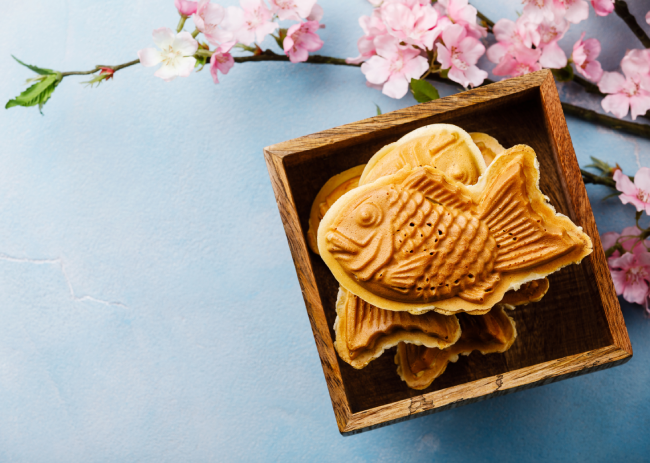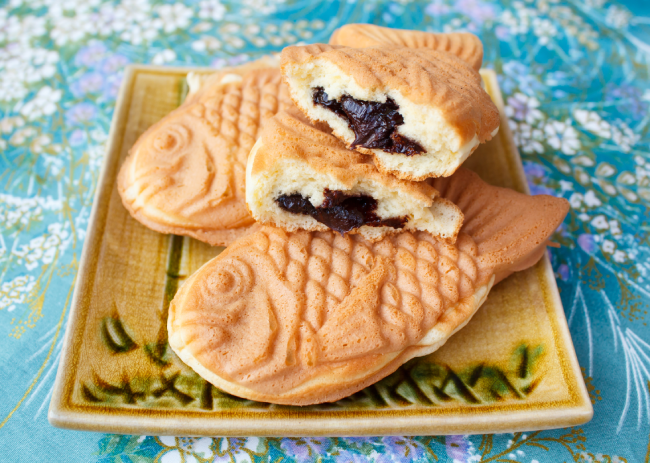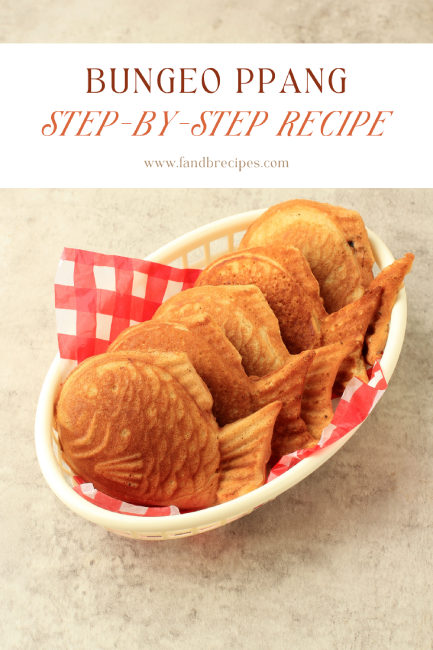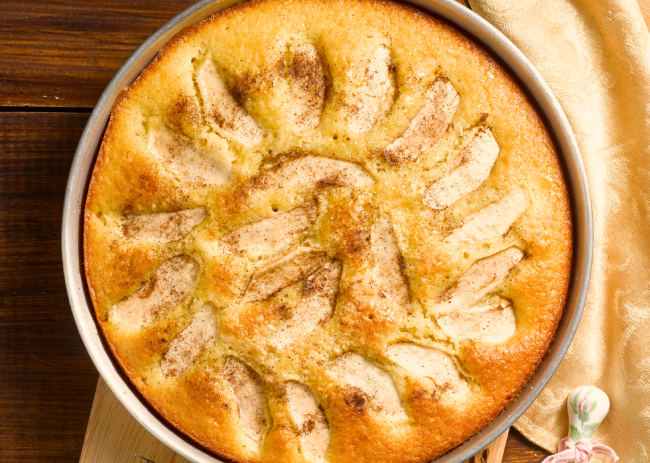Bungeo Ppang: Step-By-Step Recipe
Bungeo Ppang is a traditional Korean food everyone is enjoying for generations. The snack is a type of pastry in the shape of a fish that contains a sweet red bean paste. The word “Bungeo” refers to carp, a type of fish whose shape the pastry is said to resemble. “Ppang” means bread. It is overall delicious (and very cute!)
While the origins of Bungeo Ppang are unknown, people say that it comes from the city of Busan in southern Korea, first introduced in the early twentieth century. It spread across the country and has since become a mainstay of Korean street food culture.
In addition, Bungeo Ppang is a distinct and delicious snack. It’s known for its sweet and savoury flavours, as well as its fluffy, crispy texture. Making Bungeo Ppang at home is a gratifying and entertaining experience for everyone. It’s best for those who enjoy cooking and experimenting with various flavours and ingredients.
We’ll show you how to make your own Bungeo Ppang at home. You can make it using simple ingredients from your local grocery shop or Asian market. With a little time and effort, you can make a batch of delectable Bungeo Ppang. It will surprise your family and friends.
What Is Bungeo Ppang?
Bungeo Ppang, a typical Korean delicacy, is a sweet, fish-shaped pastry. It contains a sweet red bean paste. A batter of flour, sugar, yeast, salt, eggs, milk, and butter pours into a fish-shaped mould to make the pastry. A teaspoon of delicious red bean paste is placed in the centre of each mould, followed by the top layer of batter. The mould then closes and fries over a flame or electric hob. Until the outside is golden brown and crispy and the inside is fluffy.
Bungeo Ppang is a popular snack in Korea. Especially during the winter months. And you can find it at street food sellers, markets, and bakeries all across the nation. Sweet red bean paste is the traditional filling. However, you can add newer variants like chocolate, cheese or sausage. The shape, texture, and filling of the snack make it a must-try for anybody visiting Korea. And eager to sample new and fascinating treats.
Why This Recipe Works
This Bungeo Ppang dish works for various reasons. First, the batter’s mix of ingredients results in a light and fluffy pastry with a crispy surface. The addition of yeast to the batter causes the pastry to rise and has a soft and airy texture. While the addition of butter and milk gives it a rich and delicious flavour.
Second, using sweet red bean paste as a filling is a traditional and classic option. It matches the pastry’s sweetness. The filling isn’t very sweet. It helps to balance off the flavours and keep the pastry from getting too sugary.
Third, the use of a fish-shaped mould is critical to the recipe’s success. The mould gives the pastry the distinctive shape of a fish, which is a crucial feature of the dish. It also aids in the uniform distribution of the filling. Ensure that each Bungeo Ppang contains the right quantity of sweet red bean paste.
Finally, the cooking method is critical to achieve the proper texture and flavour. The pastry develops a crispy and golden-brown exterior. While remaining soft and fluffy when cooked over a flame or electric hob. The cooking time is also crucial. Ensure that the pastry is cooked but not overcooked or scorched.
Ingredients Required to Make Bungeo Ppang
For The Batter
- 2 tsp Baking Powder: Baking powder is a leavening agent. It helps the pastry to rise and become light and fluffy. Sifting the baking powder ensures that it’s distributed in the batter.
- ¼ tsp Fine Sea Salt: A small amount of fine sea salt enhances the flavour of the pastry and balances the sweetness of the sugar.
- 1 cup Plain Flour or Cake Flour: The type of flour in this recipe can be either plain flour or cake flour. Both types of flour have a low protein content, which helps to create a light and fluffy texture in the pastry. Sifting the flour helps to remove any lumps. And ensures that the flour is distributed in the batter.
- 175 ml Milk or Water: Milk or water helps the batter to create a smooth and pourable consistency. Milk adds a rich and creamy flavour to the pastry, while water creates a lighter texture.
- 1 Egg: The egg helps to bind the ingredients together and creates a light and fluffy texture in the pastry. It also adds richness and flavour to the pastry.
- 3 tbsp Castor Sugar: Castor sugar, also known as superfine sugar, will help to sweeten the pastry. It dissolves fast in the batter and helps to create a light and tender crumb.
- 1 tbsp Melted Butter: Melted butter adds richness and flavour to the pastry. While also helping to create a tender texture.
Filling Options
- 1 tbsp Sweetened Red Bean Paste: Sweetened red bean paste is a classic filling for Bungeo Ppang. It consists of boiled and mashed azuki beans sweetened with sugar or honey. The resulting paste has a smooth and creamy texture with a nutty and slightly sweet flavour. It complements the pastry.
- 1 tbsp Chocolate: Chocolate is another popular filling option for Bungeo Ppang. It can be in the form of chocolate chips, chocolate ganache, or melted chocolate. The chocolate adds a rich and indulgent flavour to the pastry and pairs well with the crispy texture.
- 1 tbsp Custard: Custard is a popular filling option for Bungeo Ppang. It contains a mixture of eggs, milk, sugar, and vanilla extract cooked until thick and creamy. The resulting custard has a smooth and velvety texture with a rich and sweet flavour. It pairs well with the pastry.
- 1 tbsp Nutella: Nutella is a chocolate hazelnut spread. It is a delicious filling option for Bungeo Ppang. It has a smooth and creamy texture with a rich and nutty flavour that complements the pastry.
- 1 tbsp Ham and Cheese: For those who prefer a savoury filling, ham and cheese are a tasty option. Thinly sliced ham and shredded cheese are placed inside the pastry before cooking. The heat from the cooking process melts the cheese. It creates a savoury and satisfying filling.
Tools Required to Make Bungeo Ppang
To make Bungeo Ppang, you will need the following tools:
- Bungeo Ppang Mold: The Bungeo Ppang mould is a fish-shaped mould that helps to give the pastry its unique shape.
- Mixing Bowl: In addition, A large mixing bowl helps to combine the ingredients for the batter. It should be deep enough to prevent the ingredients from splattering out of the bowl while mixing.
- Whisk or Electric Mixer: The batter mixes together with a whisk or an electric mixer. It should mix until well blended and free of lumps. For those who like a smoother batter with less effort, an electric mixer is better to use.
- Measuring Cups and Spoons: Cups and spoons will help to ensure correct ingredient measurements. It is critical for the recipe’s success.
- Pastry Brush: Before adding the batter, coat the interior of the mould with oil or butter with a pastry brush. This keeps the pastry from clinging to the mould and allows it to release when baked.
- Stove or Electric Burner: The stove or electric burner is helpful to cook the Bungeo Ppang over medium heat. Cook until it is golden brown and crispy on the outside. While still soft and fluffy on the inside.
- Small Knife: A small knife helps to cut the excess batter from around the edges of the mould before cooking. It helps to ensure that the pastry has an even and consistent shape. It is also used to check the doneness of the pastry. This is by inserting it into the centre of the pastry and checking that it comes out clean.
Bungeo Ppang Recipe
Learn how to make Bungeo Ppang: the cutesy Korean dessert known for its sweet and savoury flavours, as well as its fluffy, crispy texture.
Course: Snacks Cuisine: Korean Prep Time: 10 minutes Cook Time: 15 minutes Total Time: 25 minutes Calories: 179kcal
Firstly, in a medium mixing bowl, combine all the batter ingredients. Combine them thoroughly. Pour the mixture into a jug with a pour spout for convenient pouring.
Secondly, warm a Bungeo Ppang pan over medium-low heat. Brush the pan quickly with melted butter or cooking oil.
Pour the batter over the Bungeo Ppang pan. Cover only about half of the pan. Add your filling of choice, then top with more batter mixture to cover the fish form. Close the pan and turn it over.
Finally, cook until the fish pastry gets golden brown on both sides of the pan (approximately 2 minutes per side). Remove the fish pastry from the pan and cool fast on a rack. Serve.
Bungeo Ppang: Nutritional Information
Calories: 179 kcal (Per Serving)
Carbohydrates: 29 g
Protein: 4 g
Fat: 4 g
Saturated Fat: 2 g
Cholesterol: 34 mg
Sodium: 133 mg
Potassium: 205 mg
Sugar: 13 g
Vitamin A: 175 IU
Calcium: 99 mg
Iron: 1.3 mg
Tips To Make The Best Bungeo Ppang
Here are some tips to make the best Bungeo Ppang:
- Use Cake Flour: Cake flour has a lower protein content than all-purpose flour. It helps to create a light and fluffy texture in the pastry. Using cake flour will result in a softer and more tender Bungeo Ppang.
- Sift the Flour and Baking Powder: Sifting the flour and baking powder ensures that they are distributed in the batter. It helps to prevent lumps. This ensures that the pastry has a smooth and consistent texture.
- Let the Batter Rest: Allow the batter to rest for 10-15 minutes. Doing it before cooking allows the gluten in the flour relaxes, resulting in a softer and more tender pastry.
- Use a Non-Stick Bungeo Ppang Mold: A non-stick mould will prevent the pastry from sticking to the mould. It ensures that it releases once cooked. If you don’t have a non-stick mould, be sure to grease the mould with oil or butter.
- Don’t Overfill the Mold: Fill the mould only about two-thirds full. As the batter will rise and expand during cooking. Overfilling the mould can cause the pastry to overflow and lose its shape.
- Cook Over Low to Medium Heat: Cooking the Bungeo Ppang over low to medium heat allows the pastry to cook. It develops a golden brown and crispy exterior while remaining soft and fluffy on the inside.
- Don’t Open the Lid Too Soon: Resist the temptation to open the lid of the mould too soon. As this can cause the pastry to collapse. Wait until the pastry has risen and expanded before opening the lid.
- Serve Fresh and Warm: Bungeo Ppang is best served fresh and warm. Reheat in the oven or toaster oven if necessary, but avoid microwaving as this can make the pastry soggy.
Storing & Freezing
Bungeo Ppang is best when served hot and fresh. But you can store leftovers in an airtight container at room temperature for up to 2 days. Wrap them in a damp paper towel before storage to keep them supple and moist.
Again, if you wish to keep Bungeo Ppang for a longer period of time, you can freeze them for up to 3 months. Wrap each pastry alone in plastic wrap or aluminium foil. Place in a freezer-safe container or freezer bag to freeze. Thaw the pastries at room temperature for a few hours or in the fridge overnight before serving. Reheat them in the oven or toaster oven until warm and crispy on the outside.
Further, it’s worth noting that the texture of the pastry may alter after freezing. And it may not be as soft and fluffy as when fresh. As a result, it’s advisable to freeze them only when essential. And consume them as soon as possible for the finest taste and texture.
FAQs
What Is The Difference Between Bungeo Ppang And Taiyaki?
Bungeo Ppang and Taiyaki are two similar. But also distinct types of fish-shaped pastries. They are popular in different parts of the world.
Bungeo Ppang is a Korean pastry made with a batter of flour, sugar, baking powder, and milk or water. It contains sweetened red bean paste and other sweet or savoury fillings. The pastry then cooks in a special fish-shaped mould called a Bungeo Ppang mould. It is like a Taiyaki mould.
However, Taiyaki is a Japanese pastry that’s made with a pancake or waffle batter poured into a fish-shaped mould. It’s filled with sweet red bean paste or custard. Taiyaki has a crispy exterior and a soft, fluffy interior.
Lastly, the main difference between Bungeo Ppang and Taiyaki is in the type of batter. Bungeo Ppang contains a batter that is more of a bread or cake batter, while Taiyaki has a pancake or waffle batter. As a result, Bungeo Ppang has a softer, more cake-like texture. While Taiyaki has a crispy exterior and a lighter, fluffier interior.
What Is Bungeo Ppang In Korea?
Bungeo Ppang (분꼬빵) is a popular Korean pastry made in the shape of a fish. The name “Bungeo Ppang” translates to “carp bread”. As the pastry is shaped like a carp, a type of fish consider auspicious in Korean culture.
What Does Bungeo Ppang Taste Like?
Bungeo Ppang has a soft, fluffy texture and a slightly sweet taste. The pastry itself is like a cake or bread and has a light, airy texture that contrasts with the denser filling. The filling of sweetened red bean paste has a nutty, slightly sweet flavour. And a smooth, creamy texture that pairs well with the soft pastry. The addition of nuts or seeds to the filling can add a crunchy texture and enhance the nutty flavour.
How Much Is Bungeo Ppang In Korean?
The price of Bungeo Ppang can vary depending on where you buy it and the filling used. In general, Bungeo Ppang sold from street vendors or food trucks may cost around 1,000 to 2,000 Korean won per piece. In bakeries or cafes, the price may be a little higher, ranging from 1,500 to 3,000 Korean won per piece.
What Is National Sweet Of Korea?
The national sweet of Korea is “Hodugwaja” (호두과자), also known as walnut cookies. Hodugwaja is a traditional Korean pastry made from a batter of flour, sugar, and walnuts. It fills with a sweet filling made from red bean paste, honey, or other sweet ingredients. The pastry then bakes until golden brown. And has a crispy texture on the outside with a soft, sweet filling inside.
Moreover, Hodugwaja is popular throughout Korea and people serve it as a dessert or snack. It is especially popular during the winter months and is a common treat to enjoy with a hot cup of tea or coffee. The pastry is named after the shape of the pastry mould, which resembles a walnut shell. People designated Hodugwaja as an Intangible Cultural Heritage of Korea. People recognize it as an important part of Korean culinary culture.
In Conclusion
Bungeo Ppang is a delicious Korean pastry. It is easy to make at home with a few simple ingredients. The pastry is shaped like a fish. And it’s filled with sweetened red bean paste. Although there are many variations of fillings available today. To make Bungeo Ppang, you will need a fish-shaped mould, which can be found online or in Korean markets.
Moreover, To achieve the perfect texture, use the correct amount of materials and follow the stages. Besides this, Allow the batter to rest for a few minutes before cooking and using moderate heat. It is to ensure that the pastry cooks are two recommendations to keep in mind.
Once cooked, the Bungeo Ppang can be eaten immediately or saved for later. They can store at room temperature for a few hours or in the fridge for many days. They can freeze for extended storage and warm in the oven or microwave when ready to eat.
Lastly, Bungeo Ppang is a popular Korean snack and a wonderful way to enjoy a classic Korean pastry at home.
Whether you choose to make the red bean paste or try another, Bungeo Ppang is sure to delight your taste buds and bring a taste of Korea to your kitchen.

Bungeo Ppang: Step-By-Step Recipe
Ingredients
For The Batter:
- 2 tsp baking powder
- ¼ tsp Fine Sea Salt
- 1 cup Plain Flour or Cake Flour
- 175 ml Milk or Water
- 1 Egg
- 3 tbsp Castor Sugar
- 1 tbsp Melted Butter
Filling Options:
- 1 tbsp Sweetened Red Bean Paste
- 1 tbsp Chocolate
- 1 tbsp Custard
- 1 tbsp Nutella
- 1 tbsp Ham and Cheese
Instructions
- Firstly, in a medium mixing bowl, combine all the batter ingredients. Combine them thoroughly. Pour the mixture into a jug with a pour spout for convenient pouring.
- Secondly, warm a Bungeo Ppang pan over medium-low heat. Brush the pan quickly with melted butter or cooking oil.
- Pour the batter over the Bungeo Ppang pan. Cover only about half of the pan. Add your filling of choice, then top with more batter mixture to cover the fish form. Close the pan and turn it over.
- Finally, cook until the fish pastry gets golden brown on both sides of the pan (approximately 2 minutes per side). Remove the fish pastry from the pan and cool fast on a rack. Serve.
Notes
- Use Cake Flour: Cake flour has a lower protein content than all-purpose flour. It helps to create a light and fluffy texture in the pastry. Using cake flour will result in a softer and more tender Bungeo Ppang.
- Sift the Flour and Baking Powder: Sifting the flour and baking powder ensures that they are distributed in the batter. It helps to prevent lumps. This ensures that the pastry has a smooth and consistent texture.
- Let the Batter Rest: Allow the batter to rest for 10-15 minutes. Doing it before cooking allows the gluten in the flour relaxes, resulting in a softer and more tender pastry.
- Use a Non-Stick Bungeo Ppang Mold: A non-stick mould will prevent the pastry from sticking to the mould. It ensures that it releases once cooked. If you don't have a non-stick mould, be sure to grease the mould with oil or butter.
- Don't Overfill the Mold: Fill the mould only about two-thirds full. As the batter will rise and expand during cooking. Overfilling the mould can cause the pastry to overflow and lose its shape.
- Cook Over Low to Medium Heat: Cooking the Bungeo Ppang over low to medium heat allows the pastry to cook. It develops a golden brown and crispy exterior while remaining soft and fluffy on the inside.
- Don't Open the Lid Too Soon: Resist the temptation to open the lid of the mould too soon. As this can cause the pastry to collapse. Wait until the pastry has risen and expanded before opening the lid.
- Serve Fresh and Warm: Bungeo Ppang is best served fresh and warm. Reheat in the oven or toaster oven if necessary, but avoid microwaving as this can make the pastry soggy.








thank you for this korean pastry!!
Very tasty and delicious
wow, awesome recipe definitely i try to make this!
Bungeo Ppang-found a new snack for the evenings!
Yummmm! great recipe.
Delicious..
So tasty and nice
yummy and amazing..
Good recipe
yummy!!!!!
After trying this recipe, I can’t wait to make it again and share it with friends and family.
looks tempting
makes me crave for more